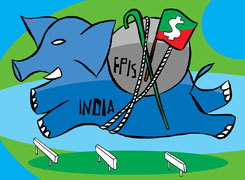Ramalingam Kalirajan |10872 Answers |Ask -Follow
Mutual Funds, Financial Planning Expert - Answered on Jul 06, 2024
He has an MBA in finance from the University of Madras and is a certified financial planner.
He is the director and chief financial planner at Holistic Investment, a Chennai-based firm that offers financial planning and wealth management advice.... more

NIPPON INDIA AMC, JK PAPERS are good to keep for long term with current prize
Understanding Direct Stock Investments
The Appeal of Nippon India AMC and JK Papers
Nippon India AMC is one of India’s leading asset management companies. It has a significant presence and manages a diverse range of funds. The asset management industry in India has tremendous growth potential, making it an attractive investment for long-term investors.
JK Papers is a key player in the paper industry. With the increasing demand for packaging and paper products, it stands out as a company with promising prospects. Its strong market position and potential for growth make it an interesting stock to consider.
Risks of Direct Stock Investment
While investing directly in stocks like Nippon India AMC and JK Papers can be rewarding, it comes with its share of risks. Stock prices can be highly volatile and influenced by various factors such as market conditions, company performance, and economic trends. This volatility requires careful monitoring and a deep understanding of the market.
Time and Expertise Required
Direct stock investment demands significant time and expertise. You need to continuously analyze market trends, company performance, and economic factors. This can be challenging, especially if you’re not well-versed in financial analysis or do not have the time to dedicate to it.
The Power of Mutual Funds
Professional Management
One of the key benefits of investing in mutual funds is professional management. Mutual funds are managed by experienced fund managers who have the expertise to make informed investment decisions. They continuously monitor the market and adjust the fund’s portfolio to optimize returns. This professional oversight can be a significant advantage over managing your own stock portfolio.
Diversification and Risk Mitigation
Mutual funds offer diversification, spreading your investment across multiple assets. This reduces the risk associated with any single stock. For example, instead of investing only in Nippon India AMC or JK Papers, a mutual fund might include a mix of stocks from different sectors. This diversified approach helps mitigate risk and provides a more balanced investment.
Ease and Convenience
Investing in mutual funds is straightforward and convenient. You don’t need to spend time researching individual stocks or monitoring the market daily. The fund manager takes care of these tasks, allowing you to focus on other aspects of your life. This convenience is particularly beneficial for investors who don’t have the time or expertise to manage a direct stock portfolio.
Flexibility in Investment Options
Mutual funds offer a wide range of options to suit different investment goals and risk appetites. Whether you’re looking for high-growth equity funds, balanced funds, or safer debt funds, there’s a mutual fund to match your needs. This flexibility allows you to build a diversified portfolio aligned with your financial goals.
Actively Managed Funds vs. Index Funds
Advantages of Actively Managed Funds
Actively managed funds aim to outperform the market by making strategic investment decisions. Fund managers actively select stocks and adjust the portfolio based on market conditions. This proactive approach can lead to better returns compared to passively managed index funds, which simply track a market index. In dynamic markets, actively managed funds can provide a significant advantage by capitalizing on opportunities and managing risks effectively.
Limitations of Index Funds
Index funds have lower fees and passively track a market index. However, they cannot outperform the market and may not adapt well to changing market conditions. In volatile markets, index funds might not offer the flexibility needed to manage risks effectively. Actively managed funds, with their strategic management and professional oversight, can provide better returns and risk management in such scenarios.
Why Avoid Direct Funds?
Benefits of Investing Through a Certified Financial Planner
Direct mutual funds eliminate intermediary commissions, which can save costs. However, investing through a Certified Financial Planner (CFP) offers several advantages. A CFP provides personalized guidance based on your financial goals and risk tolerance. They help you make informed decisions and navigate the complexities of the market. This professional support can be invaluable, especially for long-term wealth creation.
Comprehensive Financial Planning
A CFP takes a holistic view of your financial situation, helping you develop a comprehensive plan that aligns with your goals. They consider factors such as your income, expenses, savings, and future financial needs. This comprehensive approach ensures that your investments are well-planned and contribute effectively to your financial stability.
Regular Monitoring and Rebalancing
Investing through a CFP ensures regular monitoring and rebalancing of your portfolio. They adjust your investments based on market conditions and your changing financial needs. This proactive management helps you stay on track to achieve your financial goals and adapt to any changes in your financial situation.
Evaluating Your Long-Term Goals
Setting Clear Financial Goals
Before making any investment, it’s important to define your financial goals. Are you saving for retirement, buying a home, or planning for your children’s education? Clear goals help you choose the right investment options and stay focused on achieving them.
Assessing Risk Tolerance
Understand your risk tolerance before investing. Stocks and equity mutual funds can be volatile and may not suit everyone. Assess your comfort level with market fluctuations and choose investments that align with your risk profile.
Planning for the Long Term
Long-term planning is crucial for financial stability. Investments like mutual funds, with their potential for growth and compounding benefits, are ideal for long-term goals. They help you build wealth over time and provide financial security for the future.
Benefits of Mutual Funds for Long-Term Investment
Compounding Growth
Mutual funds benefit from the power of compounding, where your returns generate additional returns over time. This compounding effect can significantly enhance the growth of your investment, especially when you stay invested for the long term.
Systematic Investment Plan (SIP)
SIP is a disciplined investment approach where you invest a fixed amount regularly in a mutual fund. SIPs help you build wealth gradually and benefit from market volatility through rupee cost averaging. This systematic approach is ideal for long-term investors who want to build wealth steadily over time.
Liquidity and Flexibility
Mutual funds offer excellent liquidity, allowing you to buy or sell your units whenever you need. This flexibility is particularly beneficial if you need access to your funds for emergencies or new investment opportunities.
Building a Diversified Portfolio
Importance of Diversification
Diversification spreads your investments across different assets, reducing the impact of any single loss. A well-diversified portfolio balances risks and enhances the potential for returns. This approach is less risky compared to investing in a few individual stocks.
Combining Different Mutual Funds
Consider combining different types of mutual funds to build a balanced portfolio. Equity funds provide growth, while debt funds offer stability. Balanced funds, which invest in both equities and debt, offer a middle ground with moderate risk and returns.
Regular Review and Adjustment
Regularly review and adjust your portfolio to ensure it remains aligned with your goals. Market conditions and your financial needs can change over time. Regular monitoring and rebalancing help you stay on track and adapt to any changes.
Leveraging Professional Expertise
Role of a Certified Financial Planner
A Certified Financial Planner (CFP) provides professional guidance and support in managing your investments. They help you make informed decisions and develop a comprehensive financial plan tailored to your needs. This professional expertise is invaluable for achieving long-term financial stability.
Benefits of Fund Managers
Fund managers bring in-depth market knowledge and experience to managing mutual funds. They continuously analyze market trends and make strategic decisions to optimize returns. Their expertise and proactive management help you achieve better outcomes compared to managing your own stock investments.
Final Insights
Investing in individual stocks like Nippon India AMC and JK Papers can be rewarding but comes with significant risks and demands careful monitoring. Mutual funds offer a more balanced and convenient approach, providing professional management, diversification, and the power of compounding. By leveraging the expertise of fund managers and the guidance of a Certified Financial Planner, you can build a diversified portfolio that aligns with your long-term financial goals. Regular monitoring and strategic adjustments will ensure you stay on track to achieve financial stability and growth.
Best Regards,
K. Ramalingam, MBA, CFP,
Chief Financial Planner,
www.holisticinvestment.in
You may like to see similar questions and answers below
Advait Arora | Answer |Ask -Follow
Financial Planner - Answered on Nov 22, 2023
Advait Arora | Answer |Ask -Follow
Financial Planner - Answered on Apr 29, 2023
Samraat Jadhav |2498 Answers |Ask -Follow
Stock Market Expert - Answered on Jul 01, 2024
Nayagam P P |10851 Answers |Ask -Follow
Career Counsellor - Answered on Dec 07, 2025
Nayagam P P |10851 Answers |Ask -Follow
Career Counsellor - Answered on Dec 07, 2025
Radheshyam Zanwar |6736 Answers |Ask -Follow
MHT-CET, IIT-JEE, NEET-UG Expert - Answered on Dec 06, 2025

Good luck.
Follow me if you receive this reply.
Radheshyam
Dr Nagarajan J S K |2576 Answers |Ask -Follow
NEET, Medical, Pharmacy Careers - Answered on Dec 06, 2025
Mihir Tanna |1090 Answers |Ask -Follow
Tax Expert - Answered on Dec 06, 2025
Ramalingam Kalirajan |10872 Answers |Ask -Follow
Mutual Funds, Financial Planning Expert - Answered on Dec 06, 2025
Radheshyam Zanwar |6736 Answers |Ask -Follow
MHT-CET, IIT-JEE, NEET-UG Expert - Answered on Dec 06, 2025
Radheshyam Zanwar |6736 Answers |Ask -Follow
MHT-CET, IIT-JEE, NEET-UG Expert - Answered on Dec 06, 2025
Radheshyam Zanwar |6736 Answers |Ask -Follow
MHT-CET, IIT-JEE, NEET-UG Expert - Answered on Dec 06, 2025
Dr Dipankar Dutta |1837 Answers |Ask -Follow
Tech Careers and Skill Development Expert - Answered on Dec 05, 2025

























